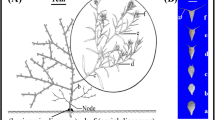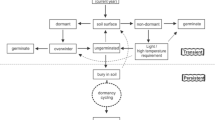Abstract
Main conclusion
Individuals of the annual halophyte Atriplex centralasiatica produce three kinds of diaspores that differ in dispersal, dormancy/germination response and type of seed bank formed, which likely is a bet-hedging strategy in the rainfall-unpredictable environment on the semi-arid, saline Ordos Plateau in Inner Mongolia, China.
Abstract
Seasonal fluctuations in environmental conditions provide germination cues for the establishment of seedlings at the right time and place to ensure plant survival and population regeneration. Diaspore heteromorphism is a phenomenon in which diaspores with stark qualitative differences in morphology and ecology are produced by the same maternal plant. Germination responses and dispersal times of the annual halophyte Atriplex centralasiatica were examined to determine the role of diaspore heteromorphism in its adaptation to salt desert conditions. A. centralasiatica is a tumbleweed that produces three types of diaspores that differ in morphology and ecophysiology. The relative potential dispersal ability and intensity of dormancy of the three diaspore types was type A (fan-shaped diaspores with yellow fruits) < type B (fan-shaped diaspores with black fruits) < type C (globular diaspores with black fruits). In the field, type A retained high germinability, but all of them were depleted from the (transient) soil seedbank in the first growing season. Types B and C cycled between dormancy and nondormancy, and 0 and > 90.0% remained in the soil seedbank 2 years after dispersal, respectively. The dormancy, dispersal and salt tolerance of type B diaspores were intermediate between those of A and C. Type A exhibited low dispersal–nondormancy, type B exhibited intermediate dispersal–intermediate dormancy and type C exhibited high dispersal ability–high dormancy. In the unpredictable salt desert habitat, the functional differences in germination and dispersal of the three diaspores act as a bet-hedging mechanism and ensure population establishment in different years by spreading germination over time and space.








Similar content being viewed by others
Abbreviations
- Type A diaspores:
-
Fan-shaped diaspores produced by Atriplex centralasiatica with yellow inner fruits
- Type B diaspores:
-
Fan-shaped diaspores produced by Atriplex centralasiatica with black inner fruits
- Type C diaspores:
-
Globular diaspores produced by Atriplex centralasiatica with black inner fruits
References
Arshad W, Sperber K, Steinbrecher T, Nichols B, Jansen VAA, Leubner-Metzger G, Mummenhoff K (2019) Dispersal biophysics and adaptive significance of dimorphic diaspores in the annual Aethionema arabicum (Brassicaceae). New Phytol 221:1434–1446
Baskin JM, Baskin CC (2004) A classification system for seed dormancy. Seed Sci Res 14:1–16
Baskin C, Baskin JM (2014) Seeds: ecology, biogeography, and evolution of dormancy and germination, 2nd edn. Elsevier/Academic Press, San Diego
Baskin JM, Lu JJ, Baskin CC, Tan DY, Wang L (2014) Diaspore dispersal ability and degree of dormancy in heteromorphic species of cold deserts of northwest China: a review. Perspect Plant Ecol Evol Syst 16:93–99
Borger CPD, Walsh M, Scott JK, Powles SB (2007) Tumbleweeds in the Western Australian cropping system: seed dispersal characteristics of Salsola australis. Weed Res 47:406–414
Cao D, Baskin CC, Baskin JM, Yang F, Huang Z (2012) Comparison of germination and seed bank dynamics of dimorphic seeds of the cold desert halophyte Suaeda corniculata subsp. mongolica. Ann Bot 110:1545–1558
China National Meteorological data Service Center (CMDC) (2012) Dataset of monthly surface observation values in individual years (1981–2010) in China. https://data.cma.cn/en/?r=data/detail&dataCode=A.0029.0004. Accessed 2 Mar 2016
Cousens R, Dytham C, Law R (2008) Dispersal in plants, a population perspective. Oxford University Press, New York
Donohue K, Rubio de Casas R, Burghardt L, Kovach K, Willis CG (2010) Germination, postgermination adaptation, and species ecological ranges. Annu Rev Ecol Evol Syst 41:293–319
Dubois J, Cheptou PO (2012) Competition/colonization syndrome mediated by early germination in non-dispersing achenes in the heteromorphic species Crepis sancta. Ann Bot 110:1245–1251
Evenari M, Kadouri A, Gutterman Y (1977) Eco-physiological investigations on the amphicarpy of Emex spinosa (L) Campd. Flora 166:223–238
Gremer JR, Kimball S, Venable DL (2016) Within- and among-year germination in Sonoran Desert winter annuals: bet hedging and predictive germination in a variable environment. Ecol Lett 19:1209–1218
Hughes PW (2018) Minimal-risk seed heteromorphism: proportions of seed morphs for optimal risk-averse heteromorphic strategies. Front Plant Sci 9:1412
Imbert E (2002) Ecological consequences and ontogeny of seed heteromorphism. Perspect Plant Ecol Evol Syst 5:13–36
Khan MA, Ungar IA (2001) Alleviation of salinity stress and the response to temperature in two seed morphs of Halopyrum mucronatum (Poaceae). Aust J Bot 49:777–783
Koller D, Roth N (1964) Studies on the ecological and physiological significance of amphicarpy in Gymnarrhena micrantha (Compositae). Am J Bot 51:26–35
Li W, An P, Liu X, Khan MA, Tsuji W, Tanaka K (2008) The effect of light, temperature and bracteoles on germination of polymorphic seeds of Atriplex centralasiatica Iljin under saline conditions. Seed Sci Technol 36:325–338
Li W, Liu X, Hanada A, Khan MA (2011) Effect of cold stratification, scarification and hormones on germination of dimorphic seeds of Atriplex centralasiatica under saline conditions. Seed Sci Technol 39:82–92
Liu X, Qiao H, Li W, Tadano T, Khan MA (2006) Comparative effect of NaCl and seawater on seed germination of Suaeda salsa and Atriplex cantralasiatica. In: Öztürk M, Waisel Y, Khan MA, Görk G (eds) Biosaline agriculture and salinity tolerance in plants. Birkhäuser, Basel, pp 45–53
Liu R, Wang L, Tanveer M, Song J (2018) Seed heteromorphism: an important adaptation of halophytes for habitat heterogeneity. Front Plant Sci 9:1515
Lu J, Tan D, Baskin JM, Baskin CC (2013) Trade-offs between seed dispersal and dormancy in an amphi-basicarpic cold desert annual. Ann Bot 112:1815–1827
Mandák B, Pyšek P (2001) Fruit dispersal and seed banks in Atriplex sagittata: the role of heterocarpy. J Ecol 89:159–165
Parsons RF (2012) Incidence and ecology of very fast germination. Seed Sci Res 22:161–167
Qiu N, Lu C (2003) Enhanced tolerance of photosynthesis against high temperature change in salt-adapted halophyte Atriplex centralasiatica plants. Plant Cell Environ 26:1137–1145
Rubio de Casas R, Kovach K, Dittmar E, Barua D, Barco B, Donohue K (2012) Seed after-ripening and dormancy determine adult life history independently of germination timing. New Phytol 194:868–879
Talavera M, Arista M, Ortiz PL (2012) Evolution of dispersal traits in a biogeographical context: a study using the heterocarpic Rumex bucephalophorus as a model. J Ecol 100:1194–1203
Thompson K, Grime JP (1979) Seasonal variation in the seed banks of herbaceous species in ten contrasting habitats. J Ecol 67:893–921
Ungar IA, Khan MA (2001) Effect of bracteoles on seed germination and dispersal of two species of Atriplex. Ann Bot 87:233–239
Venable DL (1985a) The evolutionary ecology of seed heteromorphism. Am Nat 126:577–595
Venable DL (1985b) Ecology of achene dimorphism in Heterotheca latifolia. III. Consequences of varied water availability. J Ecol 73:757–763
Walck JL, Baskin JM, Baskin CC, Hidayati SN (2005) Defining transient and persistent seed banks in species with pronounced seasonal dormancy and germination patterns. Seed Sci Res 15:189–196
Wang L, Huang Z, Baskin CC, Baskin JM, Dong M (2008) Germination of dimorphic seeds of the desert annual halophyte Suaeda aralocaspica (Chenopodiaceae), a C4 plant without kranz anatomy. Ann Bot 102:757–769
Warton DI, Hui FKC (2011) The arcsine is asinine: the analysis of proportions in ecology. Ecology 92:3–10
Wei Y, Yan C, Yi L (2003) Seed polymorphism and ecotype of Atriplex aucheri. Acta Bot Boreali Occident Sin 23:485–487 (in Chinese with English abstract)
Xu J, Yin H, Yang L, Xie Z, Liu X (2011) Differential salt tolerance in seedlings derived from dimorphic seeds of Atriplex centralasiatica: from physiology to molecular analysis. Planta 233:859–871
Young JA (1991) Tumbleweeds. Am Sci 264:58–63
Zhang K, Baskin JM, Baskin CC, Yang X, Huang Z (2015) Lack of divergence in seed ecology of two Amphicarpaea (Fabaceae) species disjunct between eastern Asia and eastern North America. Am J Bot 102:860–869
Zhang R, Wang Y, Baskin JM, Baskin CC, Luo K, Hu X (2016) Germination and persistence in soil of the dimorphic diaspores of Atriplex centralasiatica. Seed Sci Res 26:273–283
Zhou X (2009) Life history strategy of amphicarpy in Ceratocarpus arenarius L. Master’s thesis, Xinjiang Agricultural University. Urumqi (in Chinese with English abstract)
Zhu G, Mosyakin SL, Clemants SE (2003) Chenopodiaceae. In: Wu CY, Raven PH, Hong DY (eds) Flora of China, vol 5. Science Press, Beijing, Missouri Botanical Garden Press, St. Louis, p 365
Acknowledgements
This work was funded by the Key Basic Research and Development Plan of China (2016YFC0500805-02) and the National Natural Science Foundation of P. R. China (31870711, 31861143024).
Author information
Authors and Affiliations
Corresponding author
Additional information
Publisher's Note
Springer Nature remains neutral with regard to jurisdictional claims in published maps and institutional affiliations.
Electronic supplementary material
Below is the link to the electronic supplementary material.
Rights and permissions
About this article
Cite this article
Wang, Z., Baskin, J.M., Baskin, C.C. et al. Dynamics of the diaspore and germination stages of the life history of an annual diaspore-trimorphic species in a temperate salt desert. Planta 251, 87 (2020). https://doi.org/10.1007/s00425-020-03380-8
Received:
Accepted:
Published:
DOI: https://doi.org/10.1007/s00425-020-03380-8




